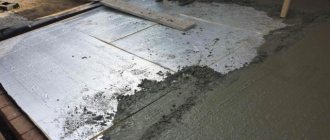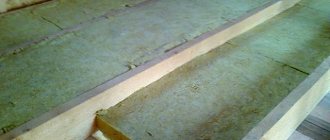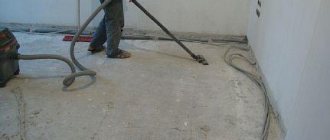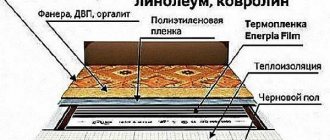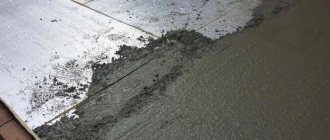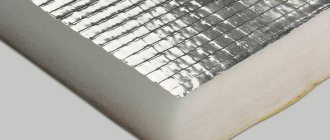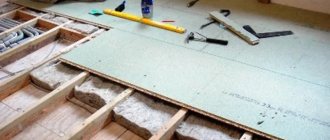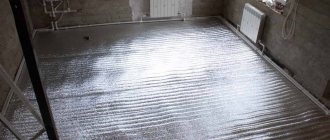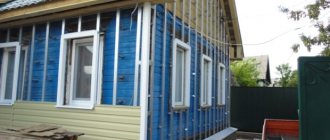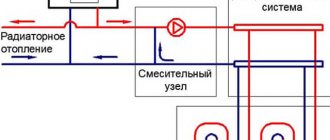Today the construction market presents a very wide range of floor coverings. The combination of a reasonable price and high quality is what sets linoleum apart from other coatings. Most linoleum is of artificial origin. This material is easy to install and maintain, which to some extent makes the coating so popular. However, if the floor in the room is cold, it will have to be additionally insulated before laying linoleum. This article will help you figure out what kind of insulation to put under linoleum on wooden floors, as well as on a concrete base.
Types of linoleum
Linoleum can have a base or be baseless. Baseless linoleum is very thin and requires special preparation before installation, since it quickly tears and wears out on an uneven surface. This coating will last up to five years, but it must be borne in mind that it has absolutely no sound or heat insulation properties.
If there is a basis, the following are distinguished:
- Foam base . It has a small thickness of about 1.5–3 mm. The foam backing retains heat to some extent and absorbs sound. It is very soft and elastic, easy to stick to corners. The base can be supplemented with fiberglass, which will protect the coating from deformation and dents. The top decorative layer is covered with a protective film, which will extend the service life of the linoleum.
- Warm base . It consists of natural or artificial jute or felt, protected by a polymer layer. A soft and elastic coating up to 5 mm thick is perfect for bedrooms and will retain enough heat. The disadvantages include the insufficient strength of the top layer. It requires special care and is not suitable for rooms with high air humidity.
Linoleum with a base will protect your feet from the cold to some extent, however, if the floor is too cold, it will still need to be insulated.
Plywood insulated floor
High-quality insulation of the base can be achieved by installing an insulated plywood floor along the joists. Logs can be used regular or adjustable. Adjustable joists are convenient to use if there are uneven floors. If the unevenness is small and regular joists are installed, the differences can be leveled by using wedges.
You can lay plywood without joists on a flat concrete surface, however, if the room is located above an unheated one, this option will not save you in the cold in winter.
Installation of plywood floor:
- Logs are installed on the screed at a distance of 300–600 mm from each other.
- If the insulation does not tolerate moisture, waterproofing is installed.
- Then thermal insulation is installed between the joists.
- The plywood is sawn into squares and laid with small gaps between the sheets, both between each other and against the walls.
- The sheets are fixed with self-tapping screws, recessing them into the thickness of the plywood.
- Gaps and screw heads are filled with elastic putty.
Video: installation of plywood floor with penoplex insulation
Advantages:
- Environmentally friendly.
- Low price.
- Strength.
- High degree of thermal insulation.
Flaws:
- Instability to moisture.
- Not installed in rooms with low ceilings.
When is underlay needed?
Laying the underlay is necessary in the following cases: when the apartment is on the ground floor, the linoleum covering is concrete, the floor is uneven. The heat-saving substrate provides the following advantages:
- Improved sound insulation.
- Getting a warm coating.
- Leveling the floor.
- Insulation from moisture coming from the concrete surface.
- Increasing the service life of linoleum.
- Protection against deformation.
The underlay can be laid on any base - wood or concrete.
Floor insulation with cork
Cork consists of the bark of the cork tree and is considered an environmentally friendly product. Installation is carried out in two ways:
- Floating way. The rolled material is rolled out over the surface, joint to joint. The sheets are connected with construction tape.
- Using glue. When laying cork slabs. Cork flooring can also be used as a finishing surface.
Video: installation of cork backing
Pros:
- Naturalness of the material.
- High sound and heat insulation.
- Wear resistance.
- Resistance to moisture.
- Can also be used for laminate and carpet.
Minuses:
- High price.
Natural materials
Natural thermal insulating substrates are made from the following materials:
- Rolled cork. This is a thin material made from balsa wood. It is mounted by gluing a concrete screed or by rolling: the unfolded coating at the joints is secured with tape.
Rolled cork - insulation for floors under linoleum
Cork insulation well insulates floors, provides warmth, and is resistant to moisture and mold. Due to its elasticity, the material protects linoleum from the appearance of dents from furniture legs.
- Jute backing is produced in rolls and consists of needle-punched jute fiber treated with a special fire-resistant and antiseptic impregnation. Advantages: hygroscopicity, noise absorption, hiding base irregularities, environmental friendliness. The material does not delaminate or crumble during installation. Service life 75 years.
- Linen insulation. This is a guarantee against the appearance of germs and mold, hypoallergenic and safe. Flax is very hygroscopic.
- Blended backing made of jute, wool and linen. Combines the properties of the materials already described and the warmth of wool. It has a high density, reliably covers the base and provides comfort.
The parameters of insulation made from natural fibers are given in the table.
| Substrate type | Thickness, mm | Density, g/m2 | Width, m | Roll length, m |
| Jute, linen, mixed | 3 | 450 | 1-2 | 10 |
| 4 | 550 | 1-2 | 10 | |
| 5 | 750 | 1-2 | 10 |
- Wood-shaving insulation.
They can be called conditionally natural, since other components are also present. There are several types of materials that can be used to insulate the floor.
Chipboard is the most budget option. The shavings are glued together using formaldehyde resin, which is a mass cut into sheets. The advantages are that the material is easy to cut and thin. The first disadvantage is that formaldehyde is present in the composition, but at normal ambient temperatures it is released in quantities that are safe for humans. The second drawback is poor retention of fasteners (screws and nails). It is securely attached only with dowels.
OSB board. Oriented strand board is made from wood chips. The fibers of one layer are located lengthwise and the other crosswise, which gives good strength. The advantages of the material are the smooth surface it creates. The average thickness of the slab is 12 mm. Sawdust may fall out when cutting. It is not moisture resistant and is therefore not recommended for laying on concrete.
Plywood is a dense glued material. It does not bend, the sheets are thick, they level the base well. The material is higher in moisture resistance than previous wooden surfaces, but still requires waterproofing when laid on concrete.
- Ecowool. This is a material that is rarely used on its own, but it is good in combination with others for laying between joists. The material is environmentally friendly, made of cellulose, breathable.
Ecowool - insulation for floors under linoleum
The general advantage of natural substrates is their composition, which is safer than synthetic insulation.
Expanded polystyrene for linoleum
Expanded polystyrene has a porous structure, which is a great advantage.
Method of installing polystyrene foam under the screed:
- Expanded polystyrene can be laid on concrete or soil. When laying on the ground, the surface is covered with crushed stone and sand in layers of 10–15 cm.
- Expanded polystyrene slabs are laid out.
- Beacons are being installed.
- A screed 5–8 cm thick is poured.
Advantages:
- High thermal insulation.
- Durability;
- High heat and sound insulation.
- Safety.
Flaws:
- Highly flammable material.
- Poor air permeability.
- Housing for rodents.
Video: floor insulation with polystyrene foam
How to style
Before placing the substrate under the laminate with foil, you should study the sequence of work:
When working with wooden bases (for example, plywood), the work process is similar to the process of installing laminate flooring on concrete bases.
In addition to laying laminate flooring over a foil backing, there is a method for installing linoleum using a backing with a reflective surface. Typically, linoleum with a backing is laid directly on top of the concrete screed. The reflective ability of the substrate is enough to ensure a normal microclimate in an apartment with such floors - it performs the function of heat protection, sound insulation and vapor barrier.
Novice builders, having learned about the positive qualities of a substrate with a reflective surface, try to use it when installing floors made of wooden structures, but they do not always understand how to put a substrate with foil under chipboard, boards or plywood.
Indeed, the properties of the foil backing make it possible to increase the protective characteristics of the floor covering, but when this material is laid on a wooden base, the integrity of the carpet is broken by self-tapping screws, which negates all the advantages.
In addition, it is undesirable to arrange such a sandwich when the finishing coating is linoleum; in this case, the wooden base ends up in the gap between two insulating surfaces, which leads to rotting of the wood and the appearance of fungus.
Laying a foil lining can be done on top of a wooden base before laying laminate or linoleum. With this installation, all the positive characteristics of the lining are preserved.
What thickness to choose
When choosing a foil backing for laminate, you need to decide on the thickness of the material. The thickness of the lining depends on the preparation of the base:
Which side should you put the foil backing on?
There is a clear answer to this question: the lining is laid exclusively with the foil side up. This ensures that heat waves are reflected into the room, which reduces the amount of heat loss by a third.
Source
Foamed polyethylene: insulation under linoleum
Foamed polyethylene has a closed-porous, light and elastic structure. Dense and fairly thick types of polyethylene foam can provide some degree of insulation. If you purchase an inexpensive thin substrate with large cells, it will not cope with the tasks assigned to it.
Pros:
- Non-toxic.
- Moisture resistant.
- Easy to install.
Minuses:
- May wrinkle under load.
- Only dense and thick types of substrate can be used as insulation.
Foil insulation consists of a foam base and a reflective foil surface.
The installation technology is very simple. The material is rolled out over the surface. The joints are sealed with aluminum tape.
Advantages of the material:
- Reflectivity.
- Resistant to temperature changes.
- Easy to install.
Flaws:
- Cannot be used for finishing with building mixtures.
- Additional insulation is required.
Recommendations
Laying the substrate is a relatively simple process, but it also has its own characteristics. Before starting work, it is advisable to obtain at least a minimum of knowledge.
Basic recommendations from the experts:
- Before purchasing the material, do an elasticity test: if the substrate makes dents when compressed, most likely it will wrinkle significantly during use
- Concrete cannot be leveled with gypsum-based mixtures - in a damp room, the gypsum can peel off, and it will not withstand the optimal load
- For a smooth, cold floor, the underlay is needed as thermal insulation - when choosing, they focus on this property
- After pouring the screed, wait for the full period of concrete to gain strength (28 days), only then install the substrate
- Laying fiberglass in areas where there is a lot of foot traffic is contraindicated.
- Before installation, special attention should be paid to cleaning the base - remove all traces of detergents, dirt, oil stains
Thermal insulation paint for insulation
The components of the paint are: water, acrylic dispersion, fiberglass additives, perlite, foam glass or ceramic microspheres.
Paint is applied to the surface with a thickness of 2–4 mm using a spray gun or a paint brush. The thickness of the paint layer affects the effectiveness of thermal insulation.
Pros:
- Resistance to high temperatures and atmospheric influences.
- Low heat transfer.
- Ability to last up to 50 years.
- Does not require special equipment for application.
- Thermal insulation.
- Corrosion protection.
- Fire resistance.
Minuses:
- Cannot be used as the main thermal insulator.
- High price for paint.
Video: technology for using heat-insulating paint
Warm floor
In addition to the above options, heated floor systems are widely used to insulate cold bases under linoleum. They can be water or electric. Thanks to this system, you can ensure a comfortable temperature regime.
Advantages of water systems:
- Creating a comfortable temperature.
- Possibility of temperature control.
- Economical.
- Safety.
Flaws:
- Possibility of bursting coolant pipes.
- Labor-intensive installation.
Video: installation instructions for a heated water floor
Advantages of electrical systems:
- Does not dry out the air.
- Warms up quickly.
- Durable.
Flaws:
- Increased energy consumption.
You can use any of the insulation methods you like. Each of the insulation options can be installed independently. If you have any questions, you can ask them on the website.
Video: installation of cable electric floor
How to style
When faced with an unusual underlay, many buyers do not know how to put the underlay under foil laminate flooring. They also don’t have an answer to the question of which side to put the foil backing on. Foamed polyethylene is cut to size and left rolled out for a day.
Then the first sheet is laid, with the obligatory approach to the walls at the points of contact. The height of the overlap is 5-10 cm (if the substrate is visible above the floor, it is carefully cut off with a construction knife and covered with a plinth). Be sure to lay the foil side up.
Since it is strictly forbidden to walk on the foil, the laminate is installed on the laid sheet. Then the second sheet is rolled out, touching the walls at the beginning and end, and end-to-end with the first sheet. The seam is glued with a special metallized tape.
The sheet substrate is laid in the same way as brickwork is laid - the connecting seams should not coincide. Wall climbing is not allowed. The sheets are laid close to each other. The seams are sealed. Just as with polyethylene underlayment, a row of underlayment is laid down and slats are placed on top of it.
During work the following must not be allowed:
In addition to laminate, such a substrate is also used for linoleum. And here many novice builders have the desire to make a sandwich: floor base-foil backing-chipboard-linoleum. They are driven by the desire to provide water and sound insulation, as well as dampen floor vibration when walking.
So how to put a backing with foil under the chipboard? No way. If the subfloor is wooden, then when attaching the chipboard to the base with self-tapping screws, the foil will be torn, and the point of laying such a substrate is lost.
On a concrete base, chipboard falls between two layers that do not allow steam to pass through: foil on the bottom, linoleum rubber on top, which is extremely undesirable. Practice shows that chipboard very often swells in such a situation.
There is another problem here: chipboard raises the floor, which does not always match the floor level in other rooms. Here it is better not to use additional layers of material at all, but to put a backing on the screed, and linoleum on top of it.
The foil backing for linoleum does not lie under the chipboard, but on the chipboard. In this case, it performs all the functions that are inherent in this type of material (details about the functions of the substrate can be found in the work “Which substrate to choose for laminate”).
For reference: if instead of chipboard you have to install plywood, then everything said for the first material also applies to it.
Insulated
It is affordable and convenient. The product is made in two layers - the base itself and the working surface. The base is felt or jute.
Polyvinyl chloride is a working surface. If you foam it, you get a durable product. Its distinctive features are softness, elasticity, and lightness. It can be quickly installed in two different ways: with or without glue. The building material also has excellent thermal insulation and sound insulation qualities.
Despite these advantages, felt products have many disadvantages:
- The working surface has a fairly low level of strength. It can be damaged without any problems. Operation must be careful.
- Due to jute or felt, building materials may lose their performance characteristics after a certain period of time. Particularly those areas with the greatest traffic are beginning to deteriorate. The base begins to become thin, even if it is Tarquette linoleum on a felt base.
- Felt-based linoleum should not be used in rooms with a high content of water vapor, because it does not have waterproofing characteristics. The base is made from products that are of natural origin and “afraid” of moisture. After a certain period of time, you may notice the appearance of fungus or mold under the work surface.
These are the disadvantages of felt.
Now it is difficult to find on the construction market something that has a base made of jute or felt. It is rapidly being replaced by a warm-based product.
On a warm basis
Thanks to modern technologies, today it is possible to create building materials consisting of many layers. Warm-based linoleum is one such building material. The product is made of five or six layers, each layer has a special function.
Unlike the previous version, inside this product there is foamed foam or foamed vinyl combined with polyester. This is an excellent insulator. Thanks to this foundation, the building material acquires elasticity and resistance to enormous loads.
It has a high level of stretch and does not rip or shrink. Thanks to its excellent waterproofing characteristics, this material perfectly tolerates high levels of humidity.
Fiberglass is the second layer.
With this layer of fiberglass it remains intact and durable. On the top of this layer there is foamed PVC, as well as a layer with a decorative pattern. And the drawing is protected by a working layer, which has distinctive wear resistance.
So, thanks to a structure consisting of many layers, this material acquires not only thermal insulation, but also noise insulation characteristics. Moisture and mechanical stress are also not a problem for this floor product.
Laying methods
Let's consider which side is the correct way to lay the insulation with foil on the floor.
Heat-saving properties depend on how correctly the insulation is installed.
Foil reflects infrared radiation, therefore, the metallized layer must be laid so that it faces the inside of the room.
Insulation of concrete floor
Place the casing with the foil side down
Most often, the rolled material is fixed to the concrete base using a special glue made on the basis of rubber.
For additional insulation of cold floors, wooden logs can be laid on top, the space between which is filled with slab insulation. Floorboards or sheet material (OSB, fiberboard, chipboard) are placed on top of it. For an interesting comparison of foil materials, watch this video:
You can secure the material with double-sided tape glued around the perimeter or dowels.
Wood floor insulation
It is most convenient to lay the material on an adhesive layer
It is most convenient to lay foil insulation on a wooden floor, which has a bottom self-adhesive layer.
If you bought material without an adhesive base, then you need to fix it with staples using a construction stapler or with double-sided tape.
Once the material has been laid, the selected flooring can be installed.
Foil insulation for heated floors
When laying insulation under heated floors, lay the material with the foil facing up so that it reflects heat into the room
The base for heated floors must be flat without differences in height or defects. All errors must be eliminated.
Stages of laying thermal insulation with a layer of foil:
Warm floors can only be turned on after the screed has completely dried. This will take about a month.
What choice should I make?
Before choosing, be sure to familiarize yourself with some nuances:
- If you need a product for rooms that have a high content of water vapor, then it is best to choose a material that has a foam core because it has excellent thermal insulation properties.
- Building materials with jute or felt inside do not need to be glued, otherwise the thermal insulation can be damaged.
- If you use an “electric floor” heating system, then you should use ordinary insulated material as a flooring product, because it is the most natural. Foamed linoleum is not needed.
Compliance with these nuances is mandatory. Linoleum with insulation can be selected according to these criteria.
How to use and handle
Most people buy underlayment and do not know how to properly lay it under linoleum with foil. They also have no idea which side to lay the substrate correctly. Foamed polyethylene must be cut to size and left open in the room for 24 hours. After a day has passed, you need to lay the first sheet so that it rests on the walls in those places where they touch. Afterwards you need to carefully cut it with a stationery knife and cover it all with a plinth. Be sure to place the substrate only with the foil facing up. Because it is forbidden to walk on it, then you need to open the second layer at the beginning and end of the wall, and right next to the first sheet. The seams must be glued with specially designed glue. The sheet should lie in the same way as brickwork is made, the seams should not touch. Afterwards, you can glue all the seams, just like with a polyethylene backing. This type of underlay is perfect for laminate flooring.
